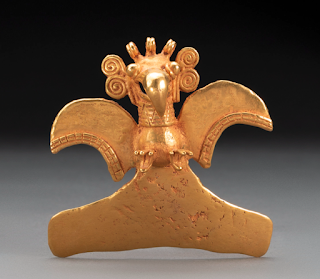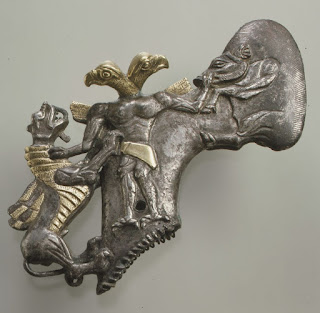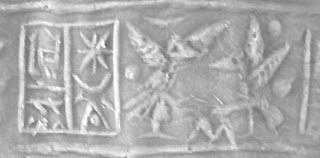Article about animal calendar markers from Central America. Today @dalaygiz posted a very interesting tweet (which unfortunately I'm not allowed to retweet) with pics of Gold "Double Headed Eagles", made in Costa Rica between 700 and 1530 AD by people of Diquis culture...
Diquis culture is best known for their stone spheres, which are littering Cost Rican landscape...But I will leave the discussion about these artefacts to others...I have nothing really to contribute to it... 🙂
Instead I will concentrate on their gold eagle pendants...Cause I think I can shed some light on their meaning 🙂...By the way they also made single headed eagle pendants too...
So what's all this about? Well remember my article about the "Double Headed Eagle" axe head, made between 2500-1500 BC in Bactria? I talked about it in my post "Double headed eagle"...
In this post I explained the emergence of a "Vulture" animal calendar marker in the area of Mesopotamia, Iran and and Central Asia...It's all to do with the local climate and the mating behaviour of old world vultures...
The climatic year in the region is divided into hot, dry half of the year (Apr/May-Oct/Nov), and cool, wet half of the year (Oct/Nov-Apr/May). And right at the beginning of the wet season, Vultures begin to mate...
During their mating season, which spans winter months (Nov, Dec, Jan), they perform courtship aerial displays, where the pairs fly together over one another with outstretched wings...
Which look like this from the ground...
Hence eagles dance
Syria, 1800BC. Eagle (vulture) couples dance above the mountains at the beginning of their mating season, which coincides with the beginning of the rain season in Fertile Crescent...
Montenegro 1963AD. Newly married couple dance Oro, Eagle Dance
I talked about this in my post about the "Eagle dance"...
And why we find that in Mesopotamia the Rain God was originally imagined as a "great black bird with outstretched wings".
I talked about it in my post "Mysterious creature". BTW, Gazelles, the animals depicted around the tree (of life) also begin mating in Oct/Nov...
This is also why we find Eagle Dudes all over this area. Left Aleppo. Right Nimrud...Why are they hiding the same bags and pine cones? Pine cone harvest season starts when vultures begin to mate and when grain sowing takes place...I talked about this in my post "Eagle dude from Aleppo"...
And in general why we find eagle dudes all over this area...I talked about this in my post "Eagle calendar marker"...
Different climate, different eagle, marking different time of the year, the same meaning: Eagle = Thunderstorm season...
Eagle-Snake struggle mosaic from the palace of the Emperor Justinian I (527-565), Istambul...This is actually a complex animal calendar marker for the thunderstorm season in Europe Apr/May - Sep/Oct, when migratory snake eagles can be seen in Europe...I talked abut this in my post "Eagle snake struggle"...
This is also why (most likely) Slavic Thunder God is called Perun...My article "Pero" is about feathers, ferns, lightning, feather/fern like lightning scars and thunder gods...Also about "pero" (feather) being the root of the name of the Slavic thunder god "Perun" which would make him "The Feathered Dude" or "The Eagle Dude"...
Ok...This is all very cool...But what does this have to do with Costa Rican eagle pendants? How are they related? Well, this morning, when I saw original tweet by @dalaygiz I had no idea if these two eagle symbols are in any way related...Now I know.
They are both animal calendar markers for the beginning of the rain season in the area where they were made...I already explained why this is true in Eurasia...Let me explain why this is true in Costa Rica...
Let's start with saying that there are two main vulture types living in Costa Rica:
Black vulture
Turkey vulture
And it seems that both of these vulture species start mating in their northern ranges in March...Costa Rica falls into "northern ranges"...
At the beginning of their mating season, both species perform courtship aerial displays. And they also dance on the ground, with their wings spread wide... 🙂 You can see a video showing it here...
And this is climatic year in Costa Rica...The rain season starts right after the vultures start dancing...
Oh and guess what. During the whole rain season, you can see this: vultures standing with their wings spread to dry them, before soaring into the air...
So if you wanted to symbolically depict "rain season" in Costa Rica, you could use a vulture with spread wings...Right?
Well, that's that...My first application of the animal calendar marker theory to American artefacts and mythology, and bingo...
It shows that this is a natural was to make calendar symbols. Using annually reoccurring events from local animal and plant life (mating, birthing, migration, flowering, fruiting) to map significant climatic and agricultural events (rain, drought, sowing, harvest)...
To read more about ancient animal and plant calendar markers, start here…then check the rest of the blog posts related to animal calendar markers I still didn't add to this page, and finally check my twitter threads I still didn't convert to blog post...I am 9 months behind now...
PS: I mean, knowing when the rain is going to come means nothing, unless you actually need it...For instance for farming maize...
And we know that maize has been farmed in Costa Rica and surrounding areas since at least 2nd millennium BC...You can read more about it in "Pre-Columbian agriculture, fire, and Spanish contact: A 4200-year record from Laguna Los Mangos, Costa Rica"...
Now in Central America, the main crop growing season, called "The Primera" season, starts in Mar with corn planting taking place between Apr and Jun...Just after vultures start dancing...
Which is kind of very important...




























No comments:
Post a Comment